Hooded Robin
Hooded RobinMelanodryas cucullata cucullata | |
|---|---|
| Kingdom: | Animalia |
| Phylum: | Chordata |
| Class: | Aves |
| Order: | Passeriformes |
| Family: | Petroicidae |
| Status | |
| World: | Least concern (IUNC 2016) |
| Australia: | Near threatened |
| Victoria: | Vulnerable (FFG Threatened List 2024) |
| South Australia: | Rare |
| New South Wales: | Vulnerable |
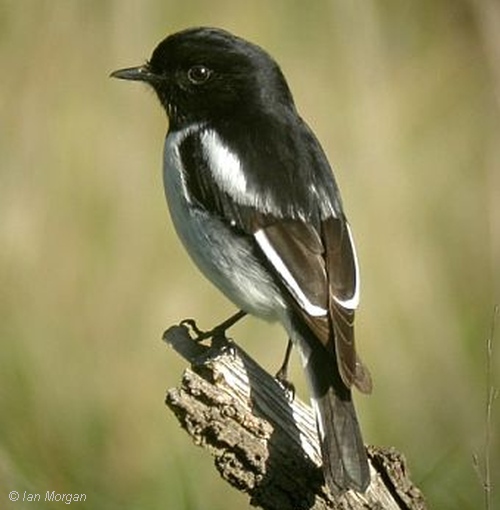
The Hooded Robin Melanodryas cucullata is widely distributed across mainland Australia and is characterised by black and white colouration in the male bird. There are three recognised sub-species in Australia with Melanodryas cucullata cucullata being found in south-eastern Australia where it is the only species of Robin to have black and white markings in the male bird.
The male Hooded Robin has a black head, throat and upperparts with white shoulders and white secondaries in the wing; its underside is white with a black tip on the tail. Females lack the black head markings and are greyer above with dark grey wings and white secondaries in the wing. The underside is grey-white.
Distribution
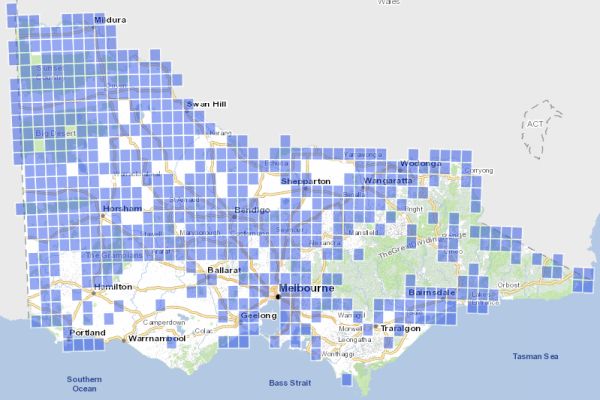
In Victoria, the Hooded Robin is mainly distributed across the Lowan Mallee, Murray Mallee ,Wimmera, Goldfields, Central Victorian Uplands, Victorian Riverina , Northern Inland Slopes and East Gippsland Uplands bioregions. The highest density of records is in the semi-arid region of North West Victoria (Emison et al. 1987).
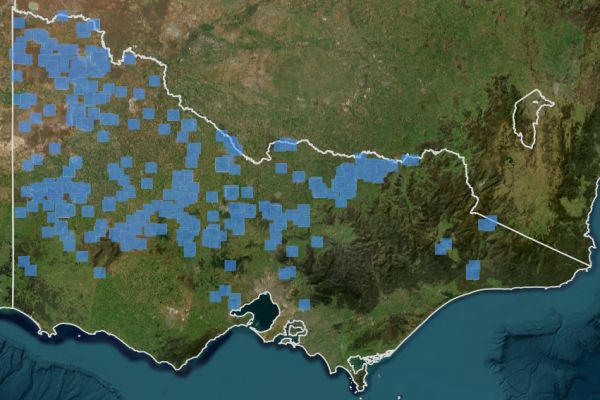
Hooded Robin records from 2000 to 2023. Note the decline in distribution from historic records above. Source VVB 2024.
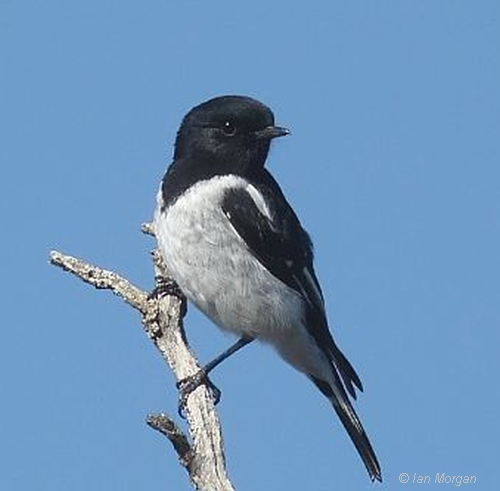
Ecology & Habitat
Habitat
Hooded Robin habitat comprises structurally diverse open woodlands containing Eucalyptus, Acacia or Callitris with an understorey of smaller trees, shrubs and grasses. They are not normally found in urban or densely forested areas. Hooded Robins are more positively associated with edge habitats, with deep and sheltered edges considered particularly important (Priday 2010).
Breeding
The main breeding season is July to November, usually with 2-3 broods. Nests are made in a tree fork or crevice up to 5 metres above ground. They breed in monogamous pairs, staying together during the whole breeding season. They are often observed in small groups and pairs.
Territories range from 10 Hectares in the breeding season to 30 Hectares in the non-breeding season. The reason for having a smaller range in breeding season is because the birds find partners and stay in breeding areas to raise the chicks.
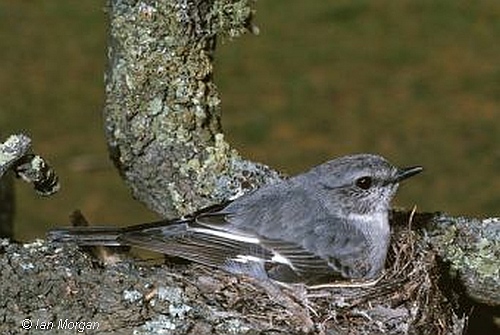
Female Hooded Robin nesting. Image: Ian Morgan.
Population Status
The Conservation status of Hooded Robin was raised from Near Threatened (DEPI 2015) to Vulnerable (FFG Threatened List 2024) due to the decline of this species range in Victoria.
Threats
Hooded Robins were once fairly common, but populations have been reduced to about a quarter of the previous distribution. There has been a decline in numbers since the 1980's in Victoria, with the rate being less than 7% in all years since detailed records began (DCE Victoria 2000).
The Hooded Robin is still found in the western districts of Victoria, with the most sightings being in the very North West, near Mildura. Numbers have declined near Melbourne, North-East Victoria, West Gippsland and East Gippsland districts where they once previously occupied. Observations in the Chiltern-Mt Pilot National Park area have detected a decline in the Hooded Robin population over recent years.
It is thought tthe Hooded Robin is locally extinct on the Mornington and Bellarine Peninsulas, French Island and in West Gippsland.
Fire (intensity and frequency) - changes in fire behaviour can result in altered vegetation structure e.g. formation of dense regrowth creating unusable habitat for the Hooded Robin which prefers more sparse vegetation. Too frequent burning can result in loss of hollows, leaf litter and woody debris which provide feeding habitat. Spring burns are considered detrimental to breeding success.
Feral cats and foxes - these are considered major threats because the Hooded Robin forages at ground level, becoming easy prey. Nests are within 5 m of ground level which can be within reach of cats.
Weed invasion - Maron and Lill (2005) found that Hooded Robins avoided foraging in sites dominated by weeds and exotic grasses. In the Big Desert major weed issues are Bridal Creeper, African Box-thorn, Cactus species, Golden Dodder, Horehound, Peppercorn/ Weeping Willow, and exotic annual grasses.
Competition - the Noisy Miner Manorina melanocephala is considered a major competitor species which can drive away Hooded Robins particularly from their preferred woodland edge habitat and woodland remnants.
Firewood collection - in certain bushland areas this is a problem due to the loss of woody debris including branches, logs and stumps which provide habitat for invertebrates and food for the Hooded Robin.
Weather - climate change has been raised as an issue which could lead to changes in vegetation, particularly invasion by a range of weeds and exotic grasses which have the potential to degrade feeding habitat.
Conservation & Management
Major initiatives are centred around protection of habitat and control of foxes and feral cats.
The care of habitat on private land is extremely important and encouraged through Landcare, Land for Wildlife, Whole farm planning, Catchment Management Authorities, Trust for Nature covenants and Birdlife Australia.
Parks Victoria manages substantial areas of reserves containing Hooded Robins. In conjunction with the Department of Environment, Land, Water & Planning (DELWP) there is an emphasis to manage areas where Hooded Robins are present through:
- Apply ecological burning.
- Monitor cat, fox and rabbit numbers and implement control activities as needed.
- Identify weed issues and take steps to control environmental weeds including exotic annual grasses, creepers and woody weeds.
- Parks Victoria provides input into regional fire management and operations plans.
- Conduct surveys to determine the abundance and extent of Hooded Robins.
Important Local Government Areas for conservation of the Hooded Robin
Parks Victoria is responsible for managing reserve areas but fringing private land with remnant woodlands also plays a key role because it comprises important habitat for the Hooded Robin.
CAMPASPE SHIRE
- Heathcote-Graytown National Park
- Rushworth-Heathcote State Forest
- Terrick Terrick National Park
- Rushworth - Murchison - Bailieston District
- Surrounding private land
EAST GIPPSLAND SHIRE
- Buchan - Snowy River rain shadow area including;
- Canni Creek,
- Mackillop's Bridge,
- Deddick,
- Bendoc and Suggan Buggan.
- Surrounding private land
GREATER BENDIGO CITY
- Greater Bendigo National Park
- Surrounding private land
HEPBURN SHIRE
- Maryborough State Forest,
- Paddys Ranges State Park,
- Dunolly-Inglewood State Forest,
- Kooroya State Forest
- Dalyenong Nature Conservation Reserve
- Timor Nature Conservation Reserve
- Havelock Nature Conservation Reserve
- Dunolly-Inglewood State Forest
- Surrounding private land
HINDMARSH SHIRE
- Glenlee Flora & Fauna Reserve
- Little Desert National Park
- Surrounding private land
INDIGO SHIRE
- Chiltern-Mt Pilot National Park
- Surrounding private land
LODDON SHIRE
- Wedderburn State Forest
- Whychitella Nature Conservation Reserve
- Borung Bushland Reserve
- Mt Korong Nature Conservation Reserve
- Terrick Terrick National Park
- Surrounding private land
MILDURA RURAL CITY
- Sunset Country
- Murray-Sunset National Park
- Hattah-Kulkyne National Park
- Yarrara Flora & Fauna Reserve
- Bannerton Flora & Fauna Reserve
- Wandown Flora & Fauna Reserve
- Surrounding private land
MITCHELL SHIRE
- Heathcote-Graytown National Park
- Surrounding private land
STRATHBOGIE SHIRE
- Heathcote-Graytown National Park
- Upotipotpon Nature Conservation Reserve
- Surrounding private land
SWAN HILL RURAL CITY
- Goschen Bushland Reserve
- Surrounding private land
WANGARATTA RURAL CITY
- Chiltern-Mt Pilot National Park
- Surrounding private land
WEST WIMMERA SHIRE
- Little Desert National Park
- West Wimmera and Wimmera Plains Including;
- Barrett Flora & Fauna Reserve
- Jilpanger Flora & Fauna Reserve
- Remnant woodlands around Nhill, Dimboola, Warracknabeal, Balmoral, Edenhope to the State border.
YARRIAMBIACK SHIRE
- Big Desert
- Wyperfeld National Park
- Timberoo Flora & Fauna Reserve
- Bronzewing Flora & Fauna Reserve
- Wathe Flora & Fauna Reserve
- Murrayville Flora Reserve
- Surrounding private land
Projects & Partnerships
The Hooded Robin was included as part of a woodland bird banding project at Snape Reserve in the Wimmera, conducted by Jonathan Starks formerly at the Wimmera Catchment Management Authority.
References & Links
- The Action Plan for Australian Birds 2000 - Australian Government, Department of Environment.
- Action Plan for Australian Birds - Species Profile – Hooded Robin pdf.
- DCE Victoria, (2000) Final Recommendation on a nomination for listing: Hooded Robin Melanodryas cucullata (Nomination no. 487). Scientific Advisory Committee, Flora and Fauna Guarantee. Department of Conservation and Environment: Melbourne.
- Department of Environment and Conservation New South Wales (2015) – Hooded Robin species profile. Accessed 18 December 2015.
- Department of Environment and Heratige South Australia – Hooded Robin fact sheet pdf.
- Emison,W.B., C.M. Beardsell, F.I. Norman, H.R. Loyn & S.C. Bennett (1987). Atlas of Victorian Birds. Melbourne: Department of Conservation (Forest & Lands) & Royal Australian Ornithological Union.
-
FFG Threatened List (2023) Flora and Fauna Guarantee Act 1988 - Threatened List - June 2023 Department of Energy, Environment and Climate Action (DEECA).
- IUCN (2012) The IUCN Red List of Threatened Species 2016: BirdLife International. 2017. Melanodryas cucullata. Accessed 3 July 2023.
- Priday, S. (2010) Beyond the ‘woody remnant’ paradigm in conservation of woodland birds: habitat requirements of the Hooded Robin (Melanodryas cucullata cucullata), Emu 110(2) 118–124. Abstract CSIRO Publishing.
- South Australia National Parks and Wildlife Act 1972—Version: 1.7.2015 Schedule 9—Rare species.
- VBA (2024) Victorian Biodiversity Atlas, Department of Energy, Environment and Climate Action, Victoria. Accessed 3 July 2023.
- VVB (2024) Visualising Victoria's Biodiversity
See also: Hooded Robin - BirdLife Australia
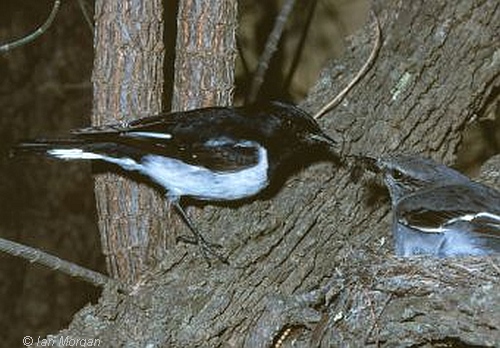
Image: Ian Morgan.

